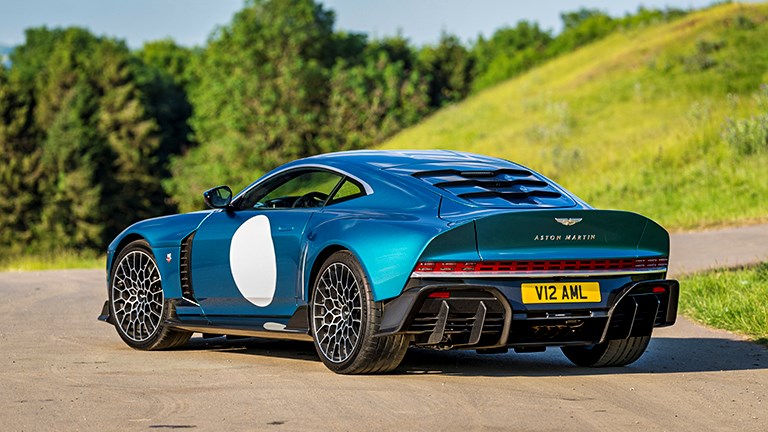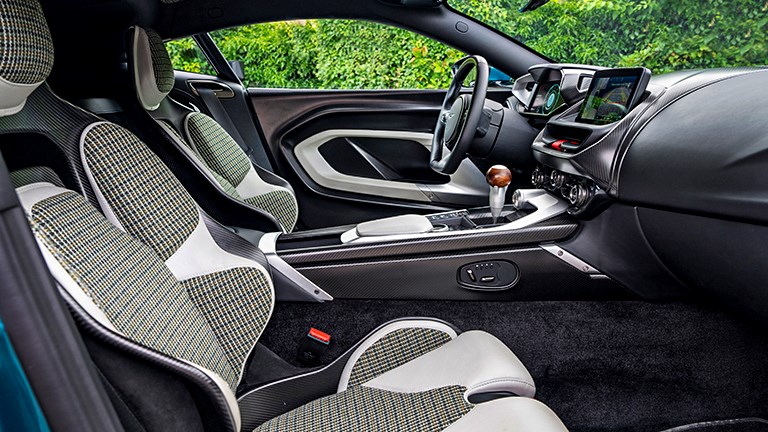► Ultra-rare Aston Martin Valour driven in UK
► Based on previous-gen Vantage with twin-turbo V12
► And a six-speed manual gearbox
All it takes is one gearchange in the Aston Martin Valour and you know that’s it. Smitten.
It’s the particular nature of the gearchange that’s key. Because it’s one manual cog swap, connected with actual metal and rods to a V12 engine, handily wrapped up in a bespoke body and yours for the cool sum of £1.5m plus options.
Pagani may have started the trend by fitting the Pagani Utopia with a manual ‘box, but by being front-engined and V12, Aston can at least claim some unique bragging rights.
The Valour is Aston’s 110th birthday present to itself, with a corresponding number being made and, as is often the way with these things at this rarefied end of the market, all sold out.

At a glance
Pros: Slick manual gearbox, old-school handling traits
Cons: Looks not to all tastes, ancient infotainment system
What’s new?
Er … the looks, as if that needed confirming. Aping the ‘Muncher’, a one-off Aston racer that ran at Le Mans in 1977, the Valour’s looks have divided opinion in the CAR office. Most hate it but I love it, and seeing as I’m the one with the type-writer, that’s the verdict we’re going for: it looks glorious.
The rear diffusor is incredibly aggressive but biased for road use, while the almost duck-tail boot lid is also there to reduce lift – neither creates downforce.
Vantage-based, the Valour has the previous gen car’s same twin-turbo V12 now producing 705bhp and 555lb ft, a smidge up on what went before in the run-out Vantage special released in 2022.
0-62mph remains the same as the last car, which isn’t altogether surprising given that the last car had an eight-speed auto while this one’s manual will inevitably be less rapid through the gears. The Valour sticks with rear-wheel drive and a mechanical limited slip diff but a new stainless steel exhaust, with a 1mm wall thickness, is meant to make it sound sharper. And also helps shed some kilos.

What are the specs?
Gaining bespoke suspension with adaptive dampers, springs and anti-roll bars all unique to the Valour, the car gets three drive modes: Sport, Sport+ and Track. These alter the throttle response and exhaust note; if you want to change the suspension or engine mapping, that’s via two buttons on either side of the steering wheel.
Aston claims that as a result of elements like bracing to the rear tower strut and fuel tank, the Valour is stiffer than the standard Vantage. Carbon ceramic brakes are standard.
How does it drive?
The odd thing about the Valour is that it’s not dominated by the V12. Of course there’s enough power to make it skip about under full throttle but the guttural roar of the twelve cylinders doesn’t become all-enveloping.
It’s not a peaky engine. The turbos come on song from 2000rpm and get interesting from 3000rpm, so it’s easy to slot it into sixth and let the torque do the work. And while 705bhp is a lot of push in old money, these days it feels almost normal.
Rather, it’s the sum of the parts that’s the difference and why this car appeals. Old school instead of modern tech. What I really enjoyed was that it reminded me of historic racers, with a lovely roll around the hips as you turn in, giving a sense of movement without being alarming. It’s balanced, with every system complementing the next.
The gearbox has a longer throw than the Honda Civic Type R’s but that doesn’t matter as it gives enough breathing space for the turbos to spool up before you want the next ratio.

The Valour isn’t class-leading anywhere and is all the better for it. The electrically assisted steering can’t compete with a McLaren’s feel and the suspension lacks the sophisticated balance between ride and handling that modern twin-valve dampers give but the Valour is no less appealing as a result.
Aston Martin Valour: Verdict
It’s difficult to not be a bit cynical about the Valour: old car dolled up and sold for a fortune. But driving and experiencing it does make you realise that it’s not just mutton dressed and that Aston has really gone to town to try to make the car appeal.
It won’t be to everyone’s tastes and there are definitely more sophisticated rivals available now. But as a statement and a glorious throwback, it’s almost unique. And all the better for it.